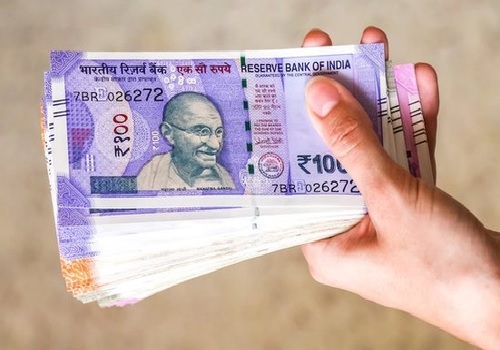Agri Commodity Technical Report 13 April 2023 - Geojit Financial Services

Follow us Now on Telegram ! Get daily 10 - 12 important updates on Business, Finance and Investment. Join our Telegram Channel
SPICES
• Jeera futures continued rising on NCDEX on Tuesday, while turmeric and coriander futures edged down. Lingering worries over yield amidst demand kept jeera prices on the bullish trajectory.
• India's export of spices during Apr-Nov declined 14% on year to 898,007 tn, according to data from the Spices Board India. In terms of value, the exports rose marginally by 0.3% to 204.8 bln rupees. Sluggish demand for most spices, including chilli, cardamom, jeera, coriander and ginger, weighed on exports. However, garlic exports rose sharply by 107% on year at 35,175.6 tn. While exports of jeera during Apr-Nov declined 17% on year to 133,250 tn, turmeric exports rose 10% on year to 111,968.5 tn. India exported 28,105 tn of coriander, which is down 15% on year, the data showed. Exports of small cardamom declined 16% on year to 5,355.4 tn. A huge decline of 59% was also seen in ginger exports at 38,765.5 tn. Exports of chilli in Apr-Nov were down 24% on year at 299,611.3 tn, while mint product exports rose 26% on year to 55,434 tn, according to the data.
• Spices Board said it had rescheduled the 14th edition of World Spice Congress from February to Sep 15-17. The congress is scheduled to be held at the CIDCO Exhibition and Convention Centre in Navi Mumbai. The rescheduling is due to constraints in international travel owing to the COVID-19 situation in some of the major spice importing countries. "The venue for the event will remain the same and all existing registrations of delegates and exhibition stalls will be carried forward to the rescheduled event," the board said.
• The value of India's spices market is expected to rise to 1 trln rupees by 2025 from 800 bln rupees this year, with the share of the organised sector likely to reach 50% from 38%, according to experts at the National Spice Conference. Currently, the value of the organised segment is pegged at 300 bln rupees. Improved quality, introduction of smaller stock-keeping units and increased shelf life of spices is one of the major reasons for growth of the organised segment, Ramkumar Menon, chairman of World Spice Organisation, said at the conference. Growth prospects in the case of spices are high and branding plays an important role, as it not only makes a memorable impression on consumers, but allows customers and clients to know what to expect from a company. It is a way to distinguish oneself from competitors and clarify what makes one a better choice, according to a panel of experts at the conference. Currently, the branded spices market is growing at a compounded annual rate of 10-15%, against 7-10% in the case of the unorganised segment. India, the world's largest producer, exporter, and consumer of spices, produces 75 of its 109 varieties. Around 85% of the spices produced in India are consumed domestically. The country accounts for more than 48% of global demand.

COTTON
• The US Department of Agriculture has scaled up its estimate for global cotton output in 2022-23 (Aug-Jul) to 115.9 mln bales (1 US bale = 218 kg) from 115.1 mln bales projected a month ago. Cotton production is expected to rise as higher production in China will balance out the reduction in Brazil's output, the department said in its World Agricultural Supply and Demand Estimates report for April. Cotton production in India in 2022-23 is seen at 24.5 mln tn, steady from estimates of the previous month. However, the output in Brazil is seen down by 300,000 tn to 13 mln tn. The agency sees global cotton consumption at 110.17 mln bales, up by 60,000 bales from projections in March due to higher demand prospects from China, which will offset the decline in Bangladesh and Brazil, the report said. Global ending stocks of cotton in 2022-23 are pegged at 92.01 mln bales, up from 91.15 mln bales projected last month. Consumption in India and Pakistan is estimated to be unchanged at 22.5 mln bales and 8.6 mln bales, respectively. The estimate for exports from India has been cut to 1.8 mln bales from 2.2 mln bales last month. Cotton ending stocks in India for 2022-23 are seen at 10.5 mln bales, higher than 10.1 mln bales projected a month ago, the report said.
• The National Commodity and Derivatives Exchange of India has announced modifications in parameters relating to trading of cotton on its platform. Among other things, NCDEX has changed the trading and delivery unit to 25 bales (170 kg) from the current 100 bales (170 kg). This modification has been introduced "in order to facilitate participation of small and medium size ginners and other market participants", it said in a release. Considering that Maharashtra is the second largest producer of cotton, and Akola is a major cotton trading centre, the exchange has announced Akola as an additional delivery centre for cotton. Currently, Kadi in Gujarat is the only delivery centre. The exchange also announced modifications in parameters such as staple length, colour grade, tolerance limit and premium or discount for delivery location differences. The modifications will be effective from Apr 11, NCDEX said.
• The Cotton Association of India has scaled down its estimate for cotton production in India in the 2022-23 (OctSep) marketing season to 31.3 mln bales (1 bale = 170 kg) from 32.2 mln bales projected a month ago, it said in a release. The association has estimated cotton production in north India, which includes Punjab, Haryana and Rajasthan, at 4.1 mln bales. In the central zone, which includes Gujarat, Maharashtra and Madhya Pradesh, output is estimated at 19.1 mln bales. Production in the South is pegged at 7.5 mln bales. Smaller states account for the rest of the output. The total supply of cotton in the 2022-23 season is estimated at 35.7 mln bales. The association estimates imports at 1.2 mln bales, 200,000 bales lower than the previous year. About 600,000 bales are estimated to have been imported by the country as of Feb 28. Exports are seen at 3.0 mln bales, lower by 1.3 mln bales from the previous year. India shipped around 800,000 bales of cotton till Feb 28, the association said. Arrivals of cotton were estimated at 15.5 mln bales for Oct-Feb, the association said. It has retained its estimate for domestic cotton consumption at 30 mln bales. As of Feb 28, domestic consumption was estimated at 12 mln bales. Ending stocks for the 2022-23 season are now estimated at 2.7 mln bales, as against 3.5 mln bales projected a month ago, the release said.

OTHERS
• Agriculture and Agri-Food Canada has scaled down its estimate for chickpea prices in Canada for 2022-23 (Aug-Jul) to $1,035 per tn from $1,165 per tn projected in February. It has also lowered its estimates for mustard seed prices to $2,365 per tn from $2,525 per tn projected last month. In its March report, the farm agency said the average price of mustard seed is forecast to fall, but remain historically high due to expectations of increased carry-out stocks in Canada. The estimate for overall supply of chickpeas in Canada is unchanged from last month at 328,000 tn. The agency has also kept exports of chickpea steady at 200,000 tn. Similarly, estimates for overall supply and exports of mustard seed are unchanged at 177,000 tn and 115,000 tn, respectively. The agency left its price estimates for lentils, dry beans and dry peas unchanged from last month at $800 per tn, $1,165 per tn and $460 per tn, respectively. Canada is one of the biggest exporters of lentils to India. Agriculture and Agri-Food Canada is responsible for policies governing production, processing and marketing of farm, food and agribased products in Canada.
• According to 2nd Advance Estimates released by farm ministry, pulses output is seen at 27.8 mln tn in the ongoing crop year, as against 27.3 mln tn in the previous year. Chana output for 2022-23 is pegged at 13.6 mln tn compared with 13.5 mln tn in 2021-22. Tur output is seen at 3.7 mln tn compared to 4.2 mln tn in the final estimate of last year.
• Rabi chana sowing ends. The area under rabi chana across the country was at 11.2 mln ha , down 2% on year, data from the farm ministry showed. The decline was primarily due to lower sowing in Andhra Pradesh, Chhattisgarh, Jharkhand, Gujarat, and Madhya Pradesh. Sowing of chana across the country has ended for the rabi season. On a week-on-week basis, the total acreage rose 0.6% from 11 mln ha, data showed. In Maharashtra, the second-largest grower, chana was sown across 2.9 mln ha, up 9.6% on year. In Rajashthan, it was sown across 2.1 mln ha, up 4.9% on year. The acreage in Madhya Pradesh, the top grower, declined 11.1% to 2.2 mln ha. In Gujarat, it fell 31% to 765,000 ha, whereas it declined by 18.2% to 341,000 ha in Andhra Pradesh.
• The Union Cabinet approved 2-9% hike in the minimum support price of six rabi crops for the coming marketing season starting April. The minimum support price of wheat has been increased by 5.5% to 2,125 rupees per 100 kg, while that of chana was raised by 2.0% to 5,335 rupees per 100 kg, the government said. Wheat, the crucial rabi crop, accounts for over 70% of the rabi foodgrain output, and chana is the largest rabi pulse crop. Minimum support prices, or the rates at which the government buys crops from farmers in case prices slip in the market, gives security and direction to growers in terms of realisation from their produce. They also help boost production of a desired crop. The Cabinet also approved increasing minimum support price of mustard by 7.9% to 5,450 rupees per 100 kg, and for masur by 9.1% to 6,000 rupees per 100 kg. The support price for barley was increased by 6.1% to 1,735 rupees per 100 kg. In the fourth advance estimate, the government predicted output of wheat in the 2021-22 (Jul-Jun) crop year at 106.8 mln tn, while oilseed production is pegged at 37.69 mln tn. Pulses output was seen at 27.69 mln tn, against 27.75 mln tn estimated in the third advance estimate.
• India’s guar split exports decreased in the month of Jan ’2023 by 32% to 3,711 tonnes compared to 5,440 tonnes previous month at an average FoB of US $1,936 per tonne in the month of Jan ’23 compared to US $1,609 per tonne previous month. However, the guar split shipments gone down by 8% in Jan ’23 compared to the same period last year. Of the total exported quantity, around 3,000 tonnes bought by China, US 630 tonnes and Switzerland 80 tonnes. India’s guar gum exports decreased in the month of January 2023 by 8% to 21,326 tonnes compared to 23,136 tonnes during previous month at an average FoB of US $1482 per tonne in the month of Jan ’2023 as compared to US $1312 per tonne previous month. Further, the gum shipments were marginally down by 0.2% in Jan ’2023 as compared to the corresponding year. Out of the total exported quantity, around 7,428 tonnes bought by USA, Russia 3,897 tonnes, Germany 1,458 tonnes, China 1,217 tonnes, Australia 1,005 tonnes and Italy 770 tonnes

OIL AND OILSEEDS
• The US Department of Agriculture has scaled down its estimate for global production of oilseeds in 2022-23 (May-Apr) to 625.4 mln tn from 629.9 mln last month. The agency projected global soybean output in 2022-23 at 369.6 mln tn, 6 mln tn lower than the estimate in March. Global soybean exports are also seen marginally lower at 168.0 mln tn compared with 168.4 mln tn last month mainly on lower exports from Uruguay, the agency said in its April report. In 2022-23, Argentina is seen exporting 3.4 mln tn of soybean, unchanged from the projection a month ago. Exports by Brazil and Paraguay are estimated at 92.7 mln tn and 6.4 mln tn, respectively. Soybean production in Brazil is estimated at 154.0 mln tn, up from 153.0 mln tn in March. Meanwhile, production in Argentina is estimated at 27.0 mln tn, down 6 mln tn from last month's projection. The agency has estimated soybean production in the US at 116.4 mln tn, unchanged from its projection last month. Brazil is the world's top producer of soybean, followed by the US and Argentina. The agency has scaled up its estimate for global ending stocks of soybean to 100.3 mln tn from 100 mln tn in March. "Soybean ending stocks are raised fractionally, with higher stocks for China and Brazil that are mostly offset by lower stocks for Argentina," the agency said. The estimate for global soyoil production in 2022-23 has been scaled down to 59.3 mln tn from 60.2 mln tn a month ago. The agency has revised its estimate for global soyoil exports in 2022- 23 marginally lower to 11.2 mln tn from 11.8 mln tn the previous month. The department has projected global soymeal output in 2022-23 at 247.6 mln tn, down from 251.4 mln tn in March. The agency estimates global exports of soymeal at 65.9 mln tn compared with 68.2 mln tn pegged last month. Soymeal, a derivative of soybean, is manufactured by crushing the oilseed and is mainly used in the production of poultry feed.
• India's soymeal exports in March rose 316.7% on year to 200,000 tn, the Soybean Processors Association of India said. For OctMar, soymeal exports increased to 999,000 tn from 474,000 tn in the previous year. The 2022-23 kharif season began in October. Soymeal is primarily used as poultry and livestock feed. Indian soymeal is non-genetically modified and considered rich in protein. In March, production of soymeal rose to 643,000 tn from 519,000 tn a year ago. The output for Oct-Mar was 4.8 mln tn, up from 3.4 mln tn in the year-ago period, SOPA said. Soybean arrivals in spot markets totalled 600,000 tn in March, unchanged against a year ago. During Oct-Mar, arrivals rose to 7.7 mln tn from 6.1 mln tn in the year-ago period. By the end of March, mills, traders, and farmers were left with around 7.1 mln tn of soybean stock, the association said. Soybean, a kharif oilseed, is sown during Jun-Jul and harvested in Sep-Oct.
• Production of crude palm oil in Malaysia fell 14.7% on month to 1.38 mln tn in January, data from the Malaysian Palm Oil Board showed. Exports of palm oil in January fell 23% on month to 1.14 mln tn, while those of biodiesel were down 5.1% on month at 14,239 tn, the data showed. Palm oil is also used to make biofuel. Total stocks of palm oil in the country were down 2.9% on month at 1.26 mln tn as of Januaryend. The production of crude palm oil in Malaysia rose 2.8% on month to 1.29 mln tn in March, data from the Malaysian Palm Oil Board showed. Exports of palm oil in March climbed 31.8% on month to 1.49 mln tn, while those of biodiesel surged 119% on month to 32,127 tn, the data showed. Palm oil is also used to make biofuel. Total stocks of palm oil in the country fell 23.2% on month to 891,653 tn as of March end. Malaysia is the world's second-largest producer of crude palm oil, and India is the largest consumer of edible oils in the world.
• India is likely to produce 11.5 mln tn of mustard in the 2022-23 crop year (Jul-Jun), 1.3 mln tn lower than the government's latest estimate, according to a recent crop survey conducted by The Solvent Extractors' Association of India. In 2021-22, India produced 12.0 mln tn of mustard, according to the data from the farm ministry. The association has estimated the country's mustard acreage at 9.6 mln ha, lower than the government's estimate of 9.8 mln ha last month. However, the acreage estimated by the association is up almost 5% on year. Mustard is one of the main crops grown in India during the rabi season. The normal area under the crop is 6.3 mln ha. Production of the oilseed is estimated to be the highest in Rajasthan at 4.5 mln tn, followed by Madhya Pradesh at 1.8 mln tn, and Uttar Pradesh at 1.7 mln tn. The association will conduct its third and final field survey in Apr-May, according to a release.
• India's oilmeal exports surged 151% on year to 471,771 tn in February, data released by the Solvent Extractors' Association of India today showed. The rise in exports was primarily on account of higher shipment of mustard meal, soymeal, and groundnut meal. In February, the country exported 141,401 tn mustard meal, significantly higher than 42,666 tn in the year-ago period. The exports of groundnut more than doubled to 1,973 tn, whereas soymeal exports rose 582% to 230,317 tn. During Apr-Feb, the export of mustard meal rose to a record 2.05 mln tn against 772,423 tn in the year-ago period, and those of soymeal rose 125.8% to 787,841 tn. During Apr-Feb, South Korea imported 880,520 tn of oilmeals from India compared with 572,198 tn a year ago, while Vietnam imported 885,146 tn from India, against 514,150 tn a year ago, the association said. In Apr-Feb, 1.12 mln tn oilmeals were exported from Kandla port against 367,166 tn a year ago. About 1.15 mln tn were exported from Mundra port, up 89.3% from last year. Exports from Mumbai port, including Jawaharlal Nehru Port Trust, were at 334,325 tn against 150,982 tn a year ago. Around 382,586 tn oilmeals were shipped from Kolkata port compared with 419,997 tn a year ago, along with 784,311 tn from other ports, up 34.0%, the association said.
• India's vegetable oil imports surged 9.3% year-on-year to 1.11 mln tn in February, the Solvent Extractors' Association of India said . The vegetable oil imports for Nov-Feb were at 5.89 mln tn against 4.69 mln tn a year ago. Meanwhile, edible oil imports for these four months were at 5.84 mln tn against 4.59 mln tn a year ago. The vegetable oil basket consists of edible and non-edible oils. The edible oil import basket comprises crude and refined palm oils, crude soyoil, sunflower oil, and mustard oil. India imports palm oil from Indonesia and Malaysia, and soyoil from Argentina. Sunflower oil is imported from Ukraine and Russia, and canola oil from Canada. India is the world's largest importer of edible oils. As of Mar 1, about 1.1 mln tn of edible oil was at ports, against 490,000 tn a year ago, and 2.4 mln tn was in the pipeline, against 1.4 mln tn in the same period last year, the SEA said.
• The Solvent Extractors' Association has signed a memorandum of understanding with small-scale farmers of sustainable palm oil in the Malaysian state of Sarawak for supply of palm oil produced by them. The pact is aimed at expanding the market for certified palm oil from Malaysia in India, according to a statement by SEA. The memorandum was signed between four parties – SEA, Solidaridad, Dayak Oil Palm Planters Association, and Persatuan Veteran Angkatan Tentera Malaysia Negeri Sarawak. "The signing of the MoU is considered as one significant step that will accelerate the market access of sustainable palm oil especially from the indigenous palm oil smallholders in Sarawak," said the industry body. Through the pact, small holders of palm oil in Sarawak will receive training on good agricultural practices and climate smart agriculture practices to improve their sustainability, productivity, and livelihood.
• The Solvent Extractors' Association of India has urged the government to procure mustard seeds as price of the oilseed is likely to fall below the minimum support price due to rise in daily arrivals. Mustard seed prices have fallen to 5,500-5,525 rupees per 100 kg in key markets of Jaipur, Rajasthan, from 6,100-6,125 rupees on Feb 1. The industry boday said the drop in prices is causing financial loss and serious distress to mustard farmers. In a letter to the secretaries of the farm ministry, food ministry, and commerce ministry, the industry body has urged raising the import duty on RBD palmolein by 20%. "This action will have a salutary effect on improving mustard prices and help improve capacity utilisation of our domestic refining industry," it said. The Union Cabinet has approved a hike in the minimum support price of mustard by 400 rupees per 100 kg for the marketing season starting in April. The current minimum support price is 5,450 rupees per 100 kg. , the oilseed was sold at 5,500-5,525 rupees per 100 kg in key markets of Jaipur, Rajasthan. Prices of edible oils, including mustard, are falling due to unrestricted import of refined palm oil, the industry body said in its letter, adding that this needs urgent policy intervention, as it compromises the nation's edible oil security.
• According to 2nd Advance Estimates released by farm ministry, the government has pegged oilseed output in 2022-23 at 40.0 mln tn against 38.0 mln tn in the previous year. It has revised its view for soybean output in 2022-23 to 14.0 mln tn from 13.0 mln tn earlier. It has pegged mustard production at 12.8 mln tn as against 12.0 mln tn last year. Groundnut output is seen at 10.06 mln tn against 10.13 mln tn in the previous year.
To Read Complete Report & Disclaimer Click Here
For More Geojit Financial Services Ltd Disclaimer https://www.geojit.com/disclaimer
SEBI Registration Number: INH200000345
Views express by all participants are for information & academic purpose only. Kindly read disclaimer before referring below views. Click Here For Disclaimer























